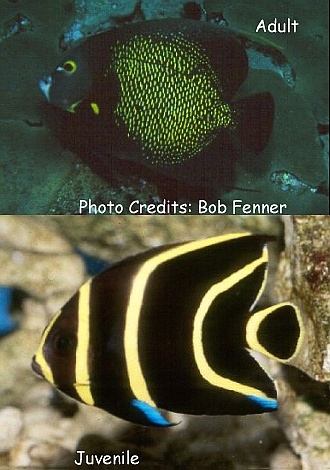
By Bob Goemans

Not Reef Tank Suitable
Likely Fish-Only Tank Suitable
Range: Western Atlantic Ocean: New York south to Bahamas, the Gulf of Mexico and the Caribbean, and south to Brazil.
Size: 15 inches (38 cm)
Natural Environment: Inhabits shallow coral reefs rich in sea fan growth at depths of 10 to 300 feet (3 – 90 m) and feeds primarily on sponges, tunicates, gorgonians, and algae.
General Husbandry: Both the juvenile and adult are quite pretty, with the juvenile entirely black except for five vertical yellow bands beginning at its mouth to the peduncle and the tail is edged in yellow. As for the adult, it has an overall black coloration, with its body scales, except the facial area, edged in a golden yellow. Its mouth area is white, eyes are rimmed in yellow, pectoral fins have a wide orange yellow band, and the dorsal fin has a long trailing yellow filament.
When first introduced into the aquarium, preferably a well-established fish-only aquarium with lots of live rock and cave areas, adults or juveniles should be offered numerous daily feedings so as to quickly acclimate it to its surroundings. Like many others in this genus, their captive diet should consist of a wide variety of frozen foods including fortified brine shrimp, mysis, and especially those containing sponge matter/angelfish food preparations and continued to be offered at least several times daily after its acclimated to its surroundings. Furthermore, flake foods, and especially those containing Spirulina and/or Nori should be also offered, along with fresh broccoli and macroalgae, as ‘greens’ make up a portion of this species diet, especially the juveniles.
Depending upon tankmates, juveniles and adults are often quite shy, and may frequently hide in caves and crevices. But as time passes, they become more outgoing, begin to establish their territory and spend more time in the open. As for adults, they are considered the least feisty in this genus, yet that somewhat depends on aquarium size and tankmates, but nevertheless, its preferable it is the last angelfish to be added to the aquarium.
Taxonomy:
Order: Perciformes
Suborder: Percoidei
Family: Pomacanthidae
Genus: Pomacanthus
FYI: Keeping more than one genus of angelfishes in the same aquarium is possible, yet depends upon several aspects. The following suggested circumstances are just that, possibilities that when heeded and adjusted to actual aquarium conditions ‘may’ make multiple angelfish collections feasible.
Aquarium size – the larger the better.
Species from the same genus should not be in the same aquarium.
The smallest and most docile genus species should be the first introduced with the largest and most malicious the last to be added.
Do not place similar coloration species in the same aquarium.
Those already in the aquarium should be well fed before adding a newcomer.
Have sufficient hiding places/rocky caves.
Do not overfeed meaty foods, especially juveniles, as it may lead to a fatty deposit around the liver that could stop production of vitamin A. This could cause blindness, often referred to as nutritional blindness.
Keep in mind all angels have cheekspines at the edge of their gill cover; therefore use caution when handling and also avoid using a net to capture it, as it may become stuck or tangled in the net and become damaged when removed.
Experience Level: Intermediate
Temperament: Semi-aggressive
Diet: Omnivore
Acclimation Time: 30 minutes+
Aquarium Environment: Fish-only and Reef Aquariums (See Below)
Reef Safe: Juveniles – Yes/Adults - No - will nip clam mantles, large and small polyped stony (LPS/SPS) corals, and also some soft corals and tubeworms.
Minimum Tank Size: 180 gallons
Temperature Range: 70 - 82°F (21 – 27°C)
Specific Gravity: 1.020 - 1.026
pH: 8.0 - 8.5
